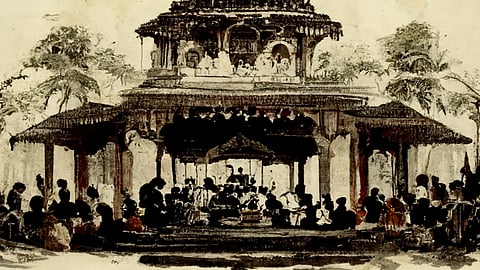- Commentary
- History Vignettes
- Notes on Culture
- Dispatches
- Podcasts
- Indian LanguagesIndian Languages
- Support

IN CARNATIC MUSIC, at the highest level, a performing artist must combine immaculate execution with the creativity of a composer. For this reason, some of the greatest performers have also been composers of distinction. Unlike a Western musician who may not know much outside the repertoire of his or her instrument, every Carnatic musician receives the same kind of training and learns roughly the same basic repertoire. The repertoire can of course vary depending on the inclination of the teacher and the student.
The vocalist still reigns supreme, a situation that used to prevail in Europe also until Beethoven and his successors banished the singer and put instrumental music in his place. Rare is the singer in Western music who can challenge the supremacy of the instrument, let alone the orchestra. This was not so in the seventeenth and the eighteenth centuries, and, happily, still not so in India.
This means that an Indian musician has to be thoroughly schooled in theory as well. It is interesting to observe that all the great composers of Carnatic music – from Purandara Dasa to Vasudevacharya – have been singers. One possible exception is Mysore Veena Seshanna, but his works are primarily instrumental.
This brings out a difference between the performance practices that prevail in Western and Indian music. While listening to Western music, one gets the feeling that the singer is imitating the instrument, while in Indian music it is exactly the opposite. This was not always so. The legendary pianist Chopin used to say: “If you want to learn how to play my music, go to the opera and listen to Pasta or Rubini sing.” It is not surprising that Western art music should have reached a dead end, as Henry Pleasants has pointed out in his Agony of Modern Music. The same will be the fate of Indian music if it ignores the singer and begins to concentrate on the instrument. Happily, there are no signs of this retrograde movement.
Nearly all great musicians are child prodigies, but Maha Shivan was prodigious even among musical prodigies. In him were combined the gifts of a vocal prodigy and musical genius of the highest order. The two rarely go together.
We are on firm ground when it comes to evaluating his greatness as a musician, for we have his own compositions and the sangatis – or cadenza - like passages – he wrote for some popular compositions by Dikshitar.
Maha Shivan’s compositions are among the towering masterpieces of Carnatic music, as good as anything composed by the ‘Great Trinity’ of Tyagaraja, Muthuswamy Dikshitar and Shyama Sastri. He was nowhere near as prolific as the three, and perhaps for that reason, the general level of his compositions is higher. There is not one note or one syllable out of place.
Then there is his magnificent Mela Raga Malika, which he composed to illustrate the musical features of all the seventy-two major ragas in a single cycle of compositions. It is a musical and pedagogical masterwork that may be compared to Bach’s ‘Well Tempered Klavier’, except that it is not restricted to one instrument. Maha Shivan is said to have scored it in a single week.
A raga consists of an ascending scale and a descending scale each containing from four to seven notes. A ‘melakarta raga’ is a complete scale containing all seven notes in both its ascending and descending scale. Unlike in Western music, where there are basically two such scales – the major and the minor – the Indian system of using half tones as well as occasional quarter tones gives seventy-two mela ragas. (This is an oversimplification, but will do for the moment.) It is worth noting that notwithstanding how they appear when written in Western notation, no interval of Indian music other than the octave corresponds to the Western. The same would no doubt be true of Western music transcribed in Indian notation. The tempered scale is unusable in Indian music.
By age twelve, Maha Shivan was recognized as an accomplished singer and musician. His prodigious voice needed no training at all, which allowed him to concentrate on theory and composition. By fourteen he was acknowledged as the greatest in all aspects of music. He was awarded the title of ‘Maha’ or great, at a learned assembly of musicians and scholars, the only one to be so recognized.
Periya Vaidyanatha Iyer (no relation), then regarded the foremost singer of the ago, generously proposed that the fourteen-year old prodigy be given the title ‘Maha’ as he would soon surpass every known musician. Ever since, he was known as Maha Vaidhyanatha Iyer, or more commonly as Maha Vaidyanatha Shivan. Even today, more than a century after his death, no one refers to him without the title ‘Maha’.
As just noted, in Maha Shivan were combined an incomparable voice and musical genius of the highest order. Like Adelina Patti, he was an accomplished singer at seven. Recognized as an outstanding performer, he could sing the Pallavi before he was eight. But unlike Patti, he was also by then a superbly schooled musician entirely at home in the creative aspects of music like improvisation of a raga without which no Carnatic musician is taken seriously.
This is not meant to detract from the genius of Western artists. If great Western singers like Patti were not so well schooled as their Indian counterparts, the blame lies less with them than the system of excessive specialization that prevails in Western music – and the tyranny of the instrument and the orchestra.
To be continued
The Dharma Dispatch is now available on Telegram! For original and insightful narratives on Indian Culture and History, subscribe to us on Telegram.
